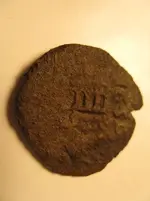The pelican "in her piety" is the symbol for the Eucharist (Christ who died for us).
This is also indicated by the "fleur-de-lis" design on the artifact's base which represents the Holy Trinity.
Three is a sacred number, as Troy expressed, and an example of this is shown on the
Archdiocese of New Orleans coat of arms which contains these flowers with a pelican "in her piety."
Troy and I knew that if the pelican did not hold the Eurcharist, then it had to be directly associated to
the altar where the sacred Eucharist was reserved.
If the interior of the church could not hang the sanctuary lamp, it was usually placed onto a beautiful
floor stand or affixed to a wall near the altar.
By maybe removing the pins either on the top or the bottom of the pelican's body, it might have been
easy for the keeper in charge to quickly gain acces for refilling and replacing the inside lighting contents.
The altar lamp could be designed into any religious shape and made with any type metal.
For all those maritime lovers, you'll appreciate this picture of a galleon sanctuary lamp
that represents Mary, Star of the Sea.
Troy, our minds worked well together. I won't forget your brilliance, kindness, and intelligence
within this field of artifact study/work.
Bonnie, again, hats off to you. By finding this one relic, you may have opened many eyes and hearts
to the Lord.
Laura



















